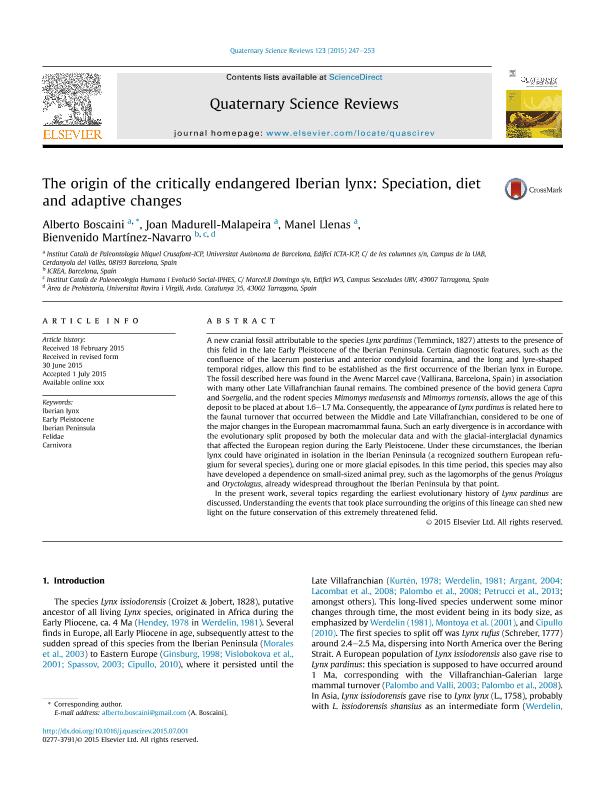Mostrar el registro sencillo del ítem
dc.contributor.author
Boscaini, Alberto

dc.contributor.author
Madurell Malapeira, Joan
dc.contributor.author
Llenas, Manel
dc.contributor.author
Martínez Navarro, Bienvenido
dc.date.available
2018-06-26T17:21:46Z
dc.date.issued
2015-09
dc.identifier.citation
Boscaini, Alberto; Madurell Malapeira, Joan; Llenas, Manel; Martínez Navarro, Bienvenido; The origin of the critically endangered Iberian lynx: Speciation, diet and adaptive changes; Pergamon-Elsevier Science Ltd; Quaternary Science Reviews; 123; 9-2015; 247-253
dc.identifier.issn
0277-3791
dc.identifier.uri
http://hdl.handle.net/11336/50100
dc.description.abstract
A new cranial fossil attributable to the species Lynx pardinus (Temminck, 1827) attests to the presence of this felid in the late Early Pleistocene of the Iberian Peninsula. Certain diagnostic features, such as the confluence of the lacerum posterius and anterior condyloid foramina, and the long and lyre-shaped temporal ridges, allow this find to be established as the first occurrence of the Iberian lynx in Europe. The fossil described here was found in the Avenc Marcel cave (Vallirana, Barcelona, Spain) in association with many other Late Villafranchian faunal remains. The combined presence of the bovid genera Capra and Soergelia, and the rodent species Mimomys medasensis and Mimomys tornensis, allows the age of this deposit to be placed at about 1.6-1.7 Ma. Consequently, the appearance of Lynx pardinus is related here to the faunal turnover that occurred between the Middle and Late Villafranchian, considered to be one of the major changes in the European macromammal fauna. Such an early divergence is in accordance with the evolutionary split proposed by both the molecular data and with the glacial-interglacial dynamics that affected the European region during the Early Pleistocene. Under these circumstances, the Iberian lynx could have originated in isolation in the Iberian Peninsula (a recognized southern European refugium for several species), during one or more glacial episodes. In this time period, this species may also have developed a dependence on small-sized animal prey, such as the lagomorphs of the genus Prolagus and Oryctolagus, already widespread throughout the Iberian Peninsula by that point. In the present work, several topics regarding the earliest evolutionary history of Lynx pardinus are discussed. Understanding the events that took place surrounding the origins of this lineage can shed new light on the future conservation of this extremely threatened felid.
dc.format
application/pdf
dc.language.iso
eng
dc.publisher
Pergamon-Elsevier Science Ltd

dc.rights
info:eu-repo/semantics/openAccess
dc.rights.uri
https://creativecommons.org/licenses/by-nc-sa/2.5/ar/
dc.subject
Carnivora
dc.subject
Early Pleistocene
dc.subject
Felidae
dc.subject
Iberian Lynx
dc.subject
Iberian Peninsula
dc.subject.classification
Meteorología y Ciencias Atmosféricas

dc.subject.classification
Ciencias de la Tierra y relacionadas con el Medio Ambiente

dc.subject.classification
CIENCIAS NATURALES Y EXACTAS

dc.subject.classification
Otras Ciencias Biológicas

dc.subject.classification
Ciencias Biológicas

dc.subject.classification
CIENCIAS NATURALES Y EXACTAS

dc.title
The origin of the critically endangered Iberian lynx: Speciation, diet and adaptive changes
dc.type
info:eu-repo/semantics/article
dc.type
info:ar-repo/semantics/artículo
dc.type
info:eu-repo/semantics/publishedVersion
dc.date.updated
2018-06-26T13:41:45Z
dc.journal.volume
123
dc.journal.pagination
247-253
dc.journal.pais
Estados Unidos

dc.description.fil
Fil: Boscaini, Alberto. Consejo Nacional de Investigaciones Científicas y Técnicas. Centro Científico Tecnológico Conicet - Mendoza. Instituto Argentino de Nivología, Glaciología y Ciencias Ambientales. Provincia de Mendoza. Instituto Argentino de Nivología, Glaciología y Ciencias Ambientales. Universidad Nacional de Cuyo. Instituto Argentino de Nivología, Glaciología y Ciencias Ambientales; Argentina. Universitat Autònoma de Barcelona; España
dc.description.fil
Fil: Madurell Malapeira, Joan. Universitat Autònoma de Barcelona; España
dc.description.fil
Fil: Llenas, Manel. Universitat Autònoma de Barcelona; España
dc.description.fil
Fil: Martínez Navarro, Bienvenido. Universitat Rovira i Virgili. Institut Català de Paleoecologia Humana i Evolució Social; España
dc.journal.title
Quaternary Science Reviews

dc.relation.alternativeid
info:eu-repo/semantics/altIdentifier/url/http://www.sciencedirect.com/science/article/pii/S0277379115300408
dc.relation.alternativeid
info:eu-repo/semantics/altIdentifier/doi/http://dx.doi.org/10.1016/j.quascirev.2015.07.001
Archivos asociados
